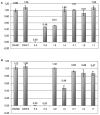Real-time PCR and linkage studies to identify carriers presenting HPRT deleted gene
- PMID: 17225873
- PMCID: PMC1770009
- DOI: 10.2119/2005-00046.Lapucci
Real-time PCR and linkage studies to identify carriers presenting HPRT deleted gene
Abstract
Lesch-Nyhan syndrome (LNS) is an X-linked genetic disorder resulting in hyperuricemia, choreoathetosis, mental retardation, and self-injurious behavior. It is caused by loss of activity of the ubiquitous enzyme hypoxanthine-guanine-phosphoribosyltransferase (HPRT). The biochemical analysis of residual HPRT activity in patients' red blood cells is the first step in LNS diagnosis, and it precedes molecular study to discover the specific mutation. Unfortunately, biochemical diagnosis of healthy carriers is difficult because HPRT enzymatic activity in blood cells is similar in LNS carriers and in healthy people; genetic tests can help reveal mutations at the genomic or cDNA level, whereas gross deletions involving the first or last exons of HPRT gene are not detectable. Until now, a test based on 6-thioguanine-resistant phenotype of HPRT mutant cells from LNS patients is the only method accepted for the diagnosis of any kind of mutation in carriers. In this work, we introduce a new approach to identify carriers of large deletions in HPRT gene using real-time PCR. Results were validated in a blinded manner with a linkage study and with results obtained in Italian families previously analyzed with selective medium test. Real-time PCR analysis clearly confirmed the results obtained by selective medium; linkage data strengthened real time results, allowing us to follow the allele with the mutated HPRT through the family pedigree. We hope that the real-time PCR approach will provide a useful and reliable method to diagnose LNS carriers of large deletions in HPRT gene.
Figures



Similar articles
-
Fluorescent approaches to diagnosis of Lesch-Nyhan syndrome and quantitative analysis of carrier status.Mol Cell Probes. 1993 Aug;7(4):311-24. doi: 10.1006/mcpr.1993.1045. Mol Cell Probes. 1993. PMID: 8232348
-
Genetic analysis of the HPRT mutation of Lesch-Nyhan syndrome in a Chinese family.Zhonghua Yi Xue Za Zhi (Taipei). 1995 Dec;56(6):359-66. Zhonghua Yi Xue Za Zhi (Taipei). 1995. PMID: 8851475
-
Molecular analysis of hypoxanthine guanine phosphoribosyltransferase (HPRT) gene in five Korean families with Lesch-Nyhan syndrome.J Korean Med Sci. 1997 Aug;12(4):332-9. doi: 10.3346/jkms.1997.12.4.332. J Korean Med Sci. 1997. PMID: 9288634 Free PMC article.
-
[Complete and partial deficiency of HPRT].Nihon Rinsho. 1996 Dec;54(12):3315-20. Nihon Rinsho. 1996. PMID: 8976112 Review. Japanese.
-
[Deficiencies of hypoxanthine guanine phosphoribosyltransferase (HPRT)].Nihon Rinsho. 2008 Apr;66(4):687-93. Nihon Rinsho. 2008. PMID: 18409516 Review. Japanese.
Cited by
-
Lesch-Nyhan Syndrome in an Indian Child.Indian J Dermatol. 2015 May-Jun;60(3):298-300. doi: 10.4103/0019-5154.156392. Indian J Dermatol. 2015. PMID: 26120162 Free PMC article.
References
-
- Nyhan WL. Clinical features if the Lesch-Nyhan syndrome. Arch Intern Med. 1972;130:186–92. - PubMed
-
- Nyhan WL. Lesch-Nyhan disease. J Hist Neurosci. 2005;14:1–10. - PubMed
-
- Page T, Bakay B, Nissinen E, Nyhan WL. Hypoxanthine-guanine phosphoribosyltransferase variants: correlation of clinical phenotype with enzyme activity. J Inherit Metab Dis. 1981;4:203–6. - PubMed
-
- Gibbs RA, Nguyen PN, Edwards A, Civitello AB, Caskey CT. Multiplex DNA deletion detection and exon sequencing of the hypoxanthine phosphoribosyltransferase gene in Lesch-Nyhan families. Genomics. 1990;7:235–44. - PubMed
MeSH terms
Substances
LinkOut - more resources
Full Text Sources
Miscellaneous
